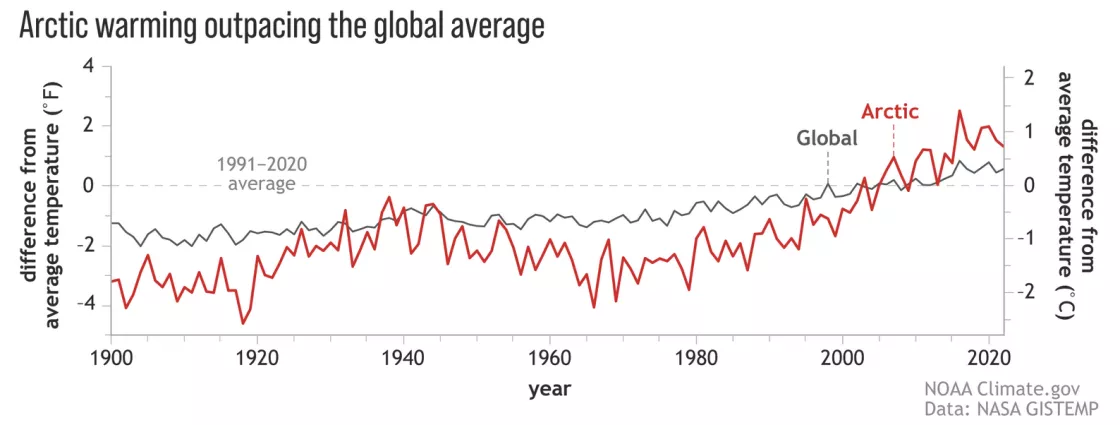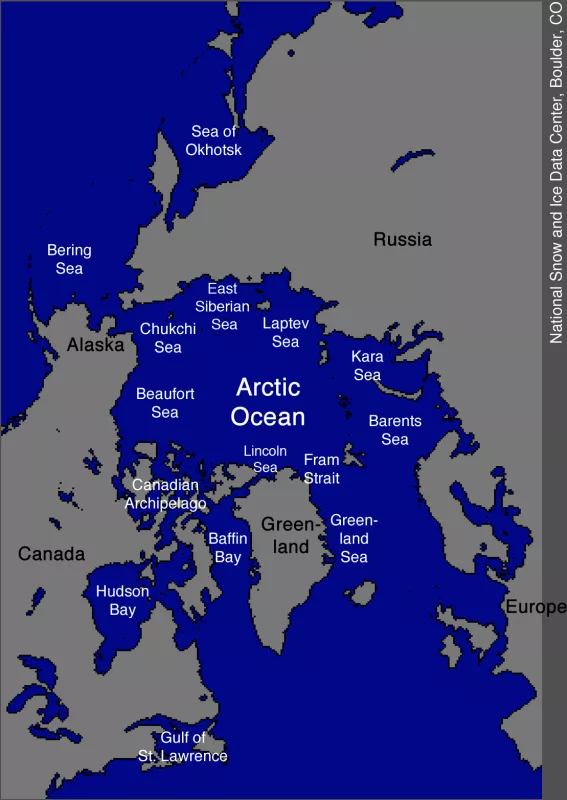By Michon Scott
Since the 1980s, extreme weather events—from stubborn heat waves to violent storms—have increased, affecting millions of people across the globe. In the United States alone, billion-dollar weather events have proliferated in recent years. Multiple studies have suggested a potential causal relationship between Arctic ice retreat and extreme weather in the midlatitudes, specifically Eurasia and North America. But not all climate scientists agree that a clear relationship exists.
The potential connection between Arctic sea ice loss and weather across the Northern Hemisphere remains an area of active research and debate. While that debate continues, a stronger case has been made for regional effects. For instance, some studies have suggested a connection between ice loss in the Barents and Kara Seas and cold outbreaks in parts of Asia. Other research has indicated that sea ice retreat may intensify weather patterns that are primarily driven by other factors, such as natural variability and conditions in the tropics.
How the relationship might work
Since 1900, global temperatures have been rising. Since 2000, Arctic temperatures have risen at twice the rate of global temperatures, possibly faster. This phenomenon is known as “Arctic amplification.”
Multiple factors contribute to the Arctic’s pronounced warming. Perhaps the most visible is enhanced springtime snowmelt on land surfaces encircling the Arctic. Because snow reflects so much of the sunlight reaching it, its earlier retreat from the landscape reveals dark soil and forest surfaces, which absorb more sunlight. This process further warms the region.
As the Arctic has warmed, sea ice has declined. Although less reflective of sunlight than snow, sea ice still bounces most sunlight back into space. This is especially true early in the sea ice melt season, when a layer of snow often blankets the ice.
The retreat of sea ice means the Arctic Ocean’s inky surface absorbs more energy. It also means, absent its customary cap of sea ice, the ocean releases more heat and moisture into the air overhead, especially in autumn. This warmer, moister atmosphere could affect the jet stream—the band of west-to-east winds that circle the globe—leaving it wavier. A wavier jet stream moves more slowly than one with a straighter trajectory, and as such it has greater potential to lodge weather patterns in place for longer periods of time. A wavier jet stream can also infuse cold polar air into mid-latitudes and warm air into polar regions. Results of a wavier jet stream might include lingering heatwaves, cold snaps reaching deeper toward the equator, floods from incessant downpours, and wildfires across the Northern Hemisphere.
Clarity consumed by complications
The link between Arctic sea ice decline and mid-latitude weather extremes attracted growing attention in the early 2010s, amid intensifying weather events across the Northern Hemisphere: worsening wildfires, historic floods, and storms such as Superstorm Sandy. A blizzard of studies suggested a strong link between Arctic sea ice decline and a havoc-wreaking wavy jet stream.
But other studies found no such relationship, or found a weak, partial, or murky relationship. Not only did scientists disagree, so did climate models. While some models found a strong correlation between Arctic sea ice loss and a slower-moving jet stream, others found little correlation, or even the possibility of a faster, stronger jet stream.
The disagreement did not involve climate change doubters; the scientists involved all accepted the evidence for global warming and Arctic amplification. They simply did not find an equally strong case for a link between sea ice decline and mid-latitude extreme weather. As studies accumulated, the relatively wavy jet stream observed in the early 2010s failed to continue throughout the rest of the decade. By the early 2020s, some research indicated that the apparent increase in jet stream waviness might have been a mirage created by natural variability.
Regional and partial relationships
Although disagreement dogged many studies by the early 2020s, some convincing evidence emerged that sea ice decline might have a discernible effect on a smaller scale.
One example of a regional link concerns sea ice in the Barents and Kara Seas. Multiple studies have found a link between low sea ice extent in this region and below-average temperatures in Central and East Asia. Another example concerns the Chukchi and Bering Seas. Some studies have identified a link between low sea ice extent in this region and anomalous cold in central and eastern North America.
Low Arctic sea ice extent may still have a long reach on a larger scale, but pinpointing the precise amount of influence is challenging. Mid-latitude weather may owe as much to tropical conditions as to Arctic sea ice. A 2021 study concluded that low sea ice extent could influence mid-latitude weather, but the ice’s influence would be smaller than the role of natural variability. Low sea ice might very well amplify the effects of preexisting weather patterns, whether they are driven by global warming, natural variability, or a combination of factors.
Sea ice and climate scientists continue to research a potential link between Arctic sea ice decline and mid-latitude weather. Stay tuned for more developments.
References
Cohen, J., Xiangdong Zhang, Francis, J., Jung, T., Kwok, R., Overland, J., Taylor, P. C., Sukyoung Lee, Laliberte, F., Feldstein, S., Wieslaw Maslowski, Henderson, G., Stroeve, J., Dim Coumou, Doerthe Handorf, Semmler, T., Ballinger, T., Hell, M., Kretschmer, M., … Smith, D. (2018). Arctic change and possible influence on mid-latitude climate and weather: A US CLIVAR White Paper. U.S. CLIVAR Project Office. https://doi.org/10.5065/D6TH8KGW
Barnes, E. A., Dunn-Sigouin, E., Masato, G., & Woollings, T. (2014). Exploring recent trends in Northern Hemisphere blocking. Geophysical Research Letters 41(2): 638–644. https://doi.org/10.1002/2013gl058745
Barnes, E. A. (2013). Revisiting the evidence linking Arctic amplification to extreme weather in midlatitudes. Geophysical Research Letters 40(17): 4734–4739. https://doi.org/10.1002/grl.50880
Cohen, J., Screen, J. A., Furtado, J. C., Barlow, M., Whittleston, D., Coumou, D., Francis, J., Dethloff, K., Entekhabi, D., Overland, J., & Jones, J. (2014). Recent Arctic amplification and extreme mid-latitude weather. Nature Geoscience 7(9): 627–637. https://doi.org/10.1038/ngeo2234
Cohen, J., Zhang, X., Francis, J., Jung, T., Kwok, R., Overland, J., Ballinger, T. J., Bhatt, U. S., Chen, H. W., Coumou, D., Feldstein, S., Gu, H., Handorf, D., Henderson, G., Ionita, M., Kretschmer, M., Laliberte, F., Lee, S., Linderholm, H. W., … Yoon, J. (2019). Divergent consensuses on Arctic amplification influence on midlatitude severe winter weather. Nature Climate Change 10(1): 20–29. https://doi.org/10.1038/s41558-019-0662-y
Cohen, J., Pfeiffer, K., & Francis, J. A. (2018). Warm Arctic episodes linked with increased frequency of extreme winter weather in the United States. Nature Communications 9(1). https://doi.org/10.1038/s41467-018-02992-9
Cohen, J., Agel, L., Barlow, M., Garfinkel, C. I., & White, I. (2021). Linking Arctic variability and change with extreme winter weather in the United States. Science 373(6559): 1116–1121. https://doi.org/10.1126/science.abi9167
Coumou, D., Di Capua, G., Vavrus, S., Wang, L., & Wang, S. (2018). The influence of Arctic amplification on mid-latitude summer circulation. Nature Communications 9(1). https://doi.org/10.1038/s41467-018-05256-8
Francis, J. A. (2018). Clarity and Clouds: Progress in Understanding Arctic Influences on Mid-latitude Weather. Arctic Report Card: Update for 2018 https://arctic.noaa.gov/Report-Card/Report-Card-2018/ArtMID/7878/ArticleID/790/Clarity-and-Clouds-Progress-in-Understanding-Arctic-Influences-on-Mid-latitude-Weather
Francis, J. A., Skific, N., & Vavrus, S. J. (2018). North American Weather Regimes Are Becoming More Persistent: Is Arctic Amplification a Factor? Geophysical Research Letters 45(20). https://doi.org/10.1029/2018gl080252
Francis, J., & Skific, N. (2015). Evidence linking rapid Arctic warming to mid-latitude weather patterns. Philosophical Transactions of the Royal Society A: Mathematical, Physical and Engineering Sciences 373(2045): 20140170. https://doi.org/10.1098/rsta.2014.0170
Francis, J. A., & Vavrus, S. J. (2015). Evidence for a wavier jet stream in response to rapid Arctic warming. In Environmental Research Letters 10(1): 014005. https://doi.org/10.1088/1748-9326/10/1/014005
Francis, J. A., & Vavrus, S. J. (2012). Evidence linking Arctic amplification to extreme weather in mid-latitudes. Geophysical Research Letters 39(6). https://doi.org/10.1029/2012gl051000
Hay, S., Kushner, P. J., Blackport, R., & McCusker, K. E. (2018). On the Relative Robustness of the Climate Response to High-Latitude and Low-Latitude Warming. Geophysical Research Letters. https://doi.org/10.1029/2018gl077294
Kretschmer, M., Coumou, D., Agel, L., Barlow, M., Tziperman, E., & Cohen, J. (2018). More-Persistent Weak Stratospheric Polar Vortex States Linked to Cold Extremes. Bulletin of the American Meteorological Society 99(1): 49–60. https://doi.org/10.1175/bams-d-16-0259.1
Lindsey, R. (2021, March 5). Understanding the Arctic polar vortex. NOAA Climate.gov. https://www.climate.gov/news-features/understanding-climate/understanding-arctic-polar-vortex
McCusker, K. E., Fyfe, J. C., & Sigmond, M. (2016). Twenty-five winters of unexpected Eurasian cooling unlikely due to Arctic sea-ice loss. Nature Geoscience 9(11): 838–842. https://doi.org/10.1038/ngeo2820
Mills, C. M., Cassano, J. J., & Cassano, E. N. (2016). Midlatitude atmospheric responses to Arctic sensible heat flux anomalies in Community Climate Model, Version 4. Geophysical Research Letters 43(23). https://doi.org/10.1002/2016gl071356
Mori, M., Watanabe, M., Shiogama, H., Inoue, J., & Kimoto, M. (2014). Robust Arctic sea-ice influence on the frequent Eurasian cold winters in past decades. Nature Geoscience 7(12): 869–873. https://doi.org/10.1038/ngeo2277
Overland, J. E., Ballinger, T. J., Cohen, J., Francis, J. A., Hanna, E., Jaiser, R., Kim, B.-M., Kim, S.-J., Ukita, J., Vihma, T., Wang, M., & Zhang, X. (2021). How do intermittency and simultaneous processes obfuscate the Arctic influence on midlatitude winter extreme weather events? Environmental Research Letters 16(4): 043002. https://doi.org/10.1088/1748-9326/abdb5d
Overland, J. E. (2016). A difficult Arctic science issue: Midlatitude weather linkages. Polar Science 10(3): 210–216. https://doi.org/10.1016/j.polar.2016.04.011
Overland, J. E., Dethloff, K., Francis, J. A., Hall, R. J., Hanna, E., Kim, S.-J., Screen, J. A., Shepherd, T. G., & Vihma, T. (2016). Nonlinear response of mid-latitude weather to the changing Arctic. Nature Climate Change 6(11): 992–999. https://doi.org/10.1038/nclimate3121
Overland, J. E. (2013). Long-range linkage. Nature Climate Change 4(1): 11–12. https://doi.org/10.1038/nclimate2079
Rantanen, M., Karpechko, A. Yu., Lipponen, A., Nordling, K., Hyvärinen, O., Ruosteenoja, K., Vihma, T., & Laaksonen, A. (2022). The Arctic has warmed nearly four times faster than the globe since 1979. Communications Earth & Environment 3(1). https://doi.org/10.1038/s43247-022-00498-3
Screen, J. A., Deser, C., & Sun, L. (2015). Projected changes in regional climate extremes arising from Arctic sea ice loss. Environmental Research Letters 10(8): 084006. https://doi.org/10.1088/1748-9326/10/8/084006
Tang, Q., Zhang, X., Yang, X., & Francis, J. A. (2013). Cold winter extremes in northern continents linked to Arctic sea ice loss. Environmental Research Letters 8(1): 014036. https://doi.org/10.1088/1748-9326/8/1/014036
Vavrus, S. J., Wang, F., Martin, J. E., Francis, J. A., Peings, Y., & Cattiaux, J. (2017). Changes in North American Atmospheric Circulation and Extreme Weather: Influence of Arctic Amplification and Northern Hemisphere Snow Cover. Journal of Climate 30(11): 4317–4333. https://doi.org/10.1175/jcli-d-16-0762.1
Warner, J. L., Screen, J. A., & Scaife, A. A. (2020). Links Between Barents‐Kara Sea Ice and the Extratropical Atmospheric Circulation Explained by Internal Variability and Tropical Forcing. Geophysical Research Letters 47(1). https://doi.org/10.1029/2019gl085679
Zhang, X., Jung, T., Wang, M., Luo, Y., Semmler, T., & Orr, A. (2017). Preface to the special issue: Towards improving understanding and prediction of Arctic change and its linkage with Eurasian mid-latitude weather and climate. Advances in Atmospheric Sciences 35(1): 1–4. https://doi.org/10.1007/s00376-017-7004-7


